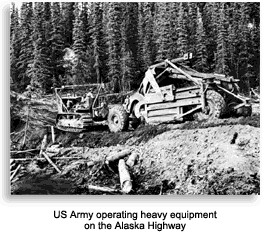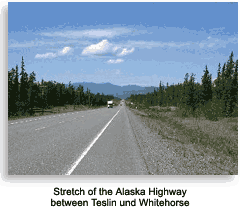The idea for the Alaska Highway began in 1938 when President Roosevelt created the Alaskan International Highway Commission. It launched America's greatest engineering feat of the modern era, which was not easy to complete.
The first goal to create the Alaska Highway was to build a road in as short as one season to avoid winter conditions. Nevertheless, weather conditions made it difficult to complete the road. When summer arrived the ground turned to mush. Dust, muskeg*, mosquitoes, black flies, and no-seeums** were only a part of the hard times that the soldiers and civilians went through to complete the 1,600-mile stretch of road.
The highway could not be started in 1938, owing to a delay attributable to American Isolationism. That was quickly put to rest following the attack on Pearl Harbor, and 11,000 soldiers with 7,500 civilians were assigned the job of building the Alaska Highway. Alaska was thought to be a target the Japanese would attack to take control of the north-south shipping lanes in the northern Pacific. That became more of a reality with the invasion of the Aleutian Islands. Following that series of attacks, it was deemed a military necessity.
The approval to start building the highway came on February 11, 1942, but construction did not begin until March. The main purpose of building the Alaskan Highway was the defense and resupply of the “Alaska Skyway,” a string of World War II airfields that dotted the Alaskan coast. As soon as the civilians and regiments of the U.S. Army Corps of Engineers began to build it, protests came from highway commissioners who disapproved of the route that was chosen by the army, which was taken from a War Department map. It was drawn along a line of existing airfields from Edmonton, Alberta, to Fairbanks, Alaska. Despite the protest, the construction began in five separate places at the same time, all working toward each other.
 When construction began, the engineers quickly ran into a problem. The route on the map did not match the suitable route on the ground. Builders had to construct segments that followed existing winter roads and old Indian trails. Some of the road followed rivers, but that was rare because the builders were afraid their construction would create landslides into the rivers.
When construction began, the engineers quickly ran into a problem. The route on the map did not match the suitable route on the ground. Builders had to construct segments that followed existing winter roads and old Indian trails. Some of the road followed rivers, but that was rare because the builders were afraid their construction would create landslides into the rivers.
In the summer of 1942, engineers utilized 20-ton bulldozers, but were only able to cover six miles a day. That was owing to subarctic forest that was difficult to push through. They built without grades or curves, making their way through the forest — wherever the bulldozer would go. Those segments were not built for cars or trucks — they were built for bulldozers.
The biggest construction hazard occurred during the summer. When the surface vegetation was removed to create the road, the frozen ground became soggy and the layer of permafrost underneath melted into a black sludge. The road cuts were then impossible to navigate and even the bulldozers that created them could not make it, let alone the trucks that brought the workers the supplies they needed. The only way to fix the problem was to bring in large loads of timber and brush to insulate the road and prevent the ground from melting underneath.
Because of the numerous holdups, cold weather arrived while the road-building was still in progress. One of the chilliest autumns experienced in the region delivered freezing temperatures that could inflict frostbite in seconds, putting the construction crews at great risk and impeding their momentum.
On September 24, 1942, soldiers from the 36th Regiment, coming from the south, and soldiers from the 340th Regiment, coming from the north, met at Contact Creek near the British Columbia-Yukon Territory border. The formal completion of the pioneer road was celebrated on November 20, 1942.
It was not until 1943 that the road was developed into a standard highway by the United States Public Roads Administration. Not many people were allowed to use the road because of wartime travel restrictions. They had to prove legitimate business in Alaska to obtain a permit, which was required so the army could determine if they were authorized.
In 1948, travel restrictions were lifted. The highway was not entirely paved until 1960. The Alaska Highway forever altered the political, economic, social, and cultural lives of Alaskans by making the territory more accessible. The highway's existence also played a key role in making Alaska a state in 1959.
 Timeline:
Timeline: